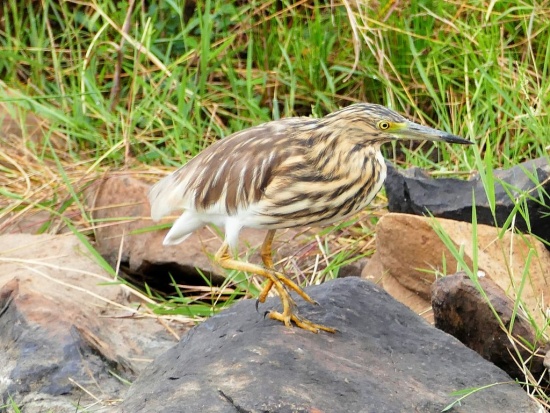(range, ref,) |
|||
| (12 intermediate revisions by 7 users not shown) | |||
| Line 1: | Line 1: | ||
| − | + | [[Image:2018-09-15 09 37 32.jpg|thumb|550px|right|Photo © by {{user|James+Kashangakii|James Kashangakii}} <br />Nairobi National Park, [[Kenya]], September 2018]] | |
| − | [[Image: | + | '''Alternative name: Madagascar Pond-Heron''' |
| + | ;[[:Category:Ardeola|Ardeola]] idae | ||
==Identification== | ==Identification== | ||
| − | + | Length 45-48 cm (17¾-19 in)<br /> | |
| − | + | '''Breeding adult''': Plumage all white, with long crest and scapular plumes. Blue bill and bare orbital skin, former with dark tip. Red legs.<br /> | |
| − | + | '''Nonbreeding adult''': Dark brown above; darker above than [[Squacco Heron]], and with broader and darker streaking on the throat and breast. | |
| − | 45-48 cm | ||
| − | |||
==Distribution== | ==Distribution== | ||
| − | + | [[Africa]]: breeds in [[Madagascar]], the [[Seychelles]], and Europa Island in the Mozambique Channel. | |
| + | Non-breeding range includes eastern [[Africa]] ([[Comoro Islands]], [[Mozambique]], [[Zimbabwe]], [[Zambia]], [[Malawi]], [[Tanzania]], [[Kenya]], [[Uganda]], [[Burundi]], [[Rwanda]], [[Democratic Republic of Congo]]).<br /> | ||
| + | Has occurred as a vagrant to [[South Africa]]. | ||
==Taxonomy== | ==Taxonomy== | ||
| + | This is a [[Dictionary_M-S#M|monotypic]] species<sup>[[#References|[1]]]</sup>.. | ||
==Habitat== | ==Habitat== | ||
| − | + | Freshwater wetlands. | |
| + | ==Status== | ||
| + | Classified as '''Endangered''' in the IUCN Red List ([http://www.birdlife.org/datazone/species/index.html BirdLife International], 2007). | ||
==Behaviour== | ==Behaviour== | ||
| − | + | They are very rarely seen in flocks. | |
| − | + | ====Diet==== | |
| − | + | They feed on fish, insects and small invertebrates., frogs, toads, geckos, skinks, grasshoppers, beetles etc. | |
| − | + | ==Gallery== | |
| − | + | Click on photo for larger image | |
| + | <gallery> | ||
| + | Image:Madagascar_Pond_Heron.jpg|Photo © by {{user|balticbird|balticbird}}<br/>Tana, [[Madagascar]]<!--EDITORS: this image does not appear in the Gallery, so retained on article--> | ||
| + | </gallery> | ||
| + | ==References== | ||
| + | #{{Ref-Clements6thAug21}}#BirdLife International (2007) | ||
| + | #Handbook of the Birds of the World Alive (retrieved June 2017) | ||
| + | #Birdforum member observations | ||
| + | {{ref}} | ||
==External Links== | ==External Links== | ||
| + | {{GSearch|Ardeola+idae}} | ||
| + | {{GS-checked}}<br /><br /> | ||
| − | [[Category:Birds]] | + | [[Category:Birds]] [[Category:Ardeola]] |
Latest revision as of 15:17, 21 January 2022
Alternative name: Madagascar Pond-Heron
- Ardeola idae
Identification
Length 45-48 cm (17¾-19 in)
Breeding adult: Plumage all white, with long crest and scapular plumes. Blue bill and bare orbital skin, former with dark tip. Red legs.
Nonbreeding adult: Dark brown above; darker above than Squacco Heron, and with broader and darker streaking on the throat and breast.
Distribution
Africa: breeds in Madagascar, the Seychelles, and Europa Island in the Mozambique Channel.
Non-breeding range includes eastern Africa (Comoro Islands, Mozambique, Zimbabwe, Zambia, Malawi, Tanzania, Kenya, Uganda, Burundi, Rwanda, Democratic Republic of Congo).
Has occurred as a vagrant to South Africa.
Taxonomy
This is a monotypic species[1]..
Habitat
Freshwater wetlands.
Status
Classified as Endangered in the IUCN Red List (BirdLife International, 2007).
Behaviour
They are very rarely seen in flocks.
Diet
They feed on fish, insects and small invertebrates., frogs, toads, geckos, skinks, grasshoppers, beetles etc.
Gallery
Click on photo for larger image
Photo © by balticbird
Tana, Madagascar
References
- Clements, J. F., T. S. Schulenberg, M. J. Iliff, S. M. Billerman, T. A. Fredericks, J. A. Gerbracht, D. Lepage, B. L. Sullivan, and C. L. Wood. 2021. The eBird/Clements checklist of Birds of the World: v2021. Downloaded from https://www.birds.cornell.edu/clementschecklist/download/
- BirdLife International (2007)
- Handbook of the Birds of the World Alive (retrieved June 2017)
- Birdforum member observations
Recommended Citation
- BirdForum Opus contributors. (2024) Malagasy Pond Heron. In: BirdForum, the forum for wild birds and birding. Retrieved 7 June 2024 from https://www.birdforum.net/opus/Malagasy_Pond_Heron
External Links
GSearch checked for 2020 platform.





